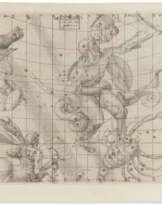ID 993301
Lot 135 | KEPLER, Johannes (1571-1630)
Estimate value
£ 20 000 – 30 000
Epitome astronomicae Copernicanae [libri I. II. III] de doctrina sphaerica. Linz: Johann Planck, 1618 – Epitomes astronomiae Copernicanae Liber quartus. Doctrinae theoricae primus: quo physica Coelestis. Linz: Johann Planck and Frankfurt: Gottfried Tampach, 1622 – Epitomes astronomiae Copernicanae libri V. VI. VII. quibus proprie doctrina theorica. Frankfurt: for Gottfried Tampach, 1621.
First editions of ‘Kepler’s longest and most influential work’ (DSB). Second issue of part two, with the title page dated 1622. Following the publication of his Astronomia nova in 1609, Kepler was asked to write a more popular exposition of Copernican astronomy; however, ‘despite its title, Kepler's Epitome was more an introduction to Keplerian than to Copernican astronomy’ (op. cit.). The work was written during a period of upheaval (Kepler's mother had been charged with witchcraft and threatened with torture, and the first volume's advocacy of the Copernican system soon earned it a place on the Index librorum prohibitorum), and the seven books were issued in three inexpensive octavo volumes, titled Doctrina spherica, Physica coelestis, and Doctrina theorica, over a period of some three years.
Intended to be an easily-comprehensible textbook of the new heliocentric astronomy, the Epitome was laid out in a catechetical form which imparted the information through questions and answers, employing a technique typical of many astronomical textbooks of the period. Beyond its stated educational purpose, the Epitome also expanded on Copernican theory – with regard to the motions of the earth, Kepler extended Copernicus' work and correctly formulated the principles which Galileo would in turn discuss in more detail in his Dialogo of 1632 – and served to expand upon Kepler's own work: ‘the most remarkable section ... was book IV, on theoretical astronomy, subtitled, 'Celestial Physics' ... to a great extent it epitomized both the Harmonice mundi [of 1619] and the new lunar theory that Kepler completed in April 1620 ... The harmonic law, which Kepler had discovered in 1619 and announced virtually without comment in the Harmonice mundi, received an extensive theoretical justification in the Epitome' (op. cit., p. 303). Carli & Favaro 76 and 92 (vols I and II); Cinti 60, 72, and 67; Houzeau & Lancaster 11831.
3 parts in one, octavo (156 x 93mm). Woodcut illustrations, head- and tail-pieces, and initials, folding letterpress table, letterpress tables in the text (repair in blank corner of title, marginal repair in T2 just affecting text, some spotting in part one and browning in part three, folding letterpress leaf restored and text partly replaced in facsimile). Contemporary vellum, remains of ties (light soiling, minor loss of vellum); housed in a custom modern box. Provenance: ‘du seminaire de ?Mirai’ (inscription on title) — faded Seminary ink stamp on title.
Special notice
No VAT is payable on the hammer price or the buyer's premium for this lot. Please see the VAT Symbols and Explanation section of the Conditions of Sale for further information
| Artist: | Johannes Kepler (1571 - 1630) |
|---|---|
| Place of origin: | Western Europe, Germany, Europe |
| Auction house category: | Printed books |
| Artist: | Johannes Kepler (1571 - 1630) |
|---|---|
| Place of origin: | Western Europe, Germany, Europe |
| Auction house category: | Printed books |
| Address of auction |
CHRISTIE'S 8 King Street, St. James's SW1Y 6QT London United Kingdom | |
|---|---|---|
| Preview |
| |
| Phone | +44 (0)20 7839 9060 | |
| Buyer Premium | see on Website | |
| Conditions of purchase | Conditions of purchase |














